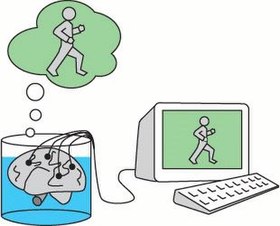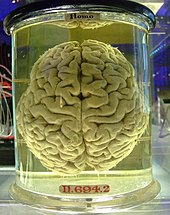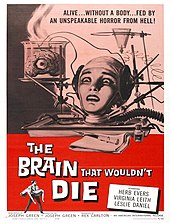Brain in a vat

In philosophy, the brain in a vat (BIV) is a scenario used in a variety of thought experiments intended to draw out certain features of human conceptions of knowledge, reality, truth, mind, consciousness, and meaning. Originated by Gilbert Harman,[1] Hilary Putnam turned the scenario into a modernized version of René Descartes's evil demon thought experiment. Following many science fiction stories, the scenario involves a mad scientist that might remove a person's brain from the body, suspend it in a vat of life-sustaining liquid, and connect its neurons by wires to a supercomputer that would provide it with electrical impulses identical to those a brain normally receives.[2] According to such stories, the computer would then be simulating reality (including appropriate responses to the brain's own output) and the "disembodied" brain would continue to have perfectly normal conscious experiences, such as those of a person with an embodied brain, without these being related to objects or events in the real world. According to Putnam, the thought of "being a brain-in-a-vat" (BIV) is either false or meaningless. Considered a cornerstone of Semantic externalism, the argument produced significant literature. The Matrix franchise and other fictional works (below) are considered inspired by Putnam's argument.[3]
Intuitive version
Putnam's argument is based on the causal theory of reference, where a word describing a spatio-temporal object is meaningful if and only if it possesses an information-carrying causal relation to whatever it denotes. Next, an "envatted" brain is one whose entire world is composed of (say) electric manipulations performed by a computer simulation to which it is connected. With this much in place, consider the sentence "I am a brain in a vat" (BIV). In case you are not a brain in a vat, the sentence is false by definition. In case you are a brain in a vat, the terms "brain" and "vat" fail to denote actual brains and actual vats with whom you had an information-carrying causal interaction since, again by definition, the only interaction available is with the computer simulation, which is not information carrying. By the causal theory of reference, such references do not carry referential meaning. Thus, the sentence "I am a brain in a vat" is either false or meaningless.[2]
Uses
The simplest use of brain-in-a-vat scenarios is as an argument for philosophical skepticism[4] and solipsism. A simple version of this runs as follows: since the brain in a vat gives and receives exactly the same impulses as it would if it were in a skull, and since these are its only way of interacting with its environment, then it is not possible to tell, from the perspective of that brain, whether it is in a skull or a vat. Yet in the first case, most of the person's beliefs may be true (if they believe, say, that they are walking down the street, or eating ice-cream); in the latter case, their beliefs are false. Since the argument says if one cannot know whether one is a brain in a vat, then one cannot know whether most of one's beliefs might be completely false. Since, in principle, it is impossible to rule out oneself being a brain in a vat, there cannot be good grounds for believing any of the things one believes; a skeptical argument would contend that one certainly cannot know them, raising issues with the definition of knowledge. Other philosophers have drawn upon sensation and its relationship to meaning in order to question whether brains in vats are really deceived at all,[5] thus raising wider questions concerning perception, metaphysics, and the philosophy of language.
The brain-in-a-vat is a contemporary version of the argument given in Hindu Maya illusion, Plato's Allegory of the Cave, Zhuangzi's "Zhuangzi dreamed he was a butterfly", and the evil demon in René Descartes' Meditations on First Philosophy.
Recently, many contemporary philosophers believe that virtual reality will seriously affect human autonomy as a form of brain in a vat. But another view is that VR will not destroy our cognitive structure or take away our connection with reality. On the contrary, VR will allow us to have more new propositions, new insights and new perspectives to see the world.[6]
Philosophical debates
While the disembodied brain (the brain in a vat) can be seen as a helpful thought experiment, there are several philosophical debates surrounding the plausibility of the thought experiment. If these debates conclude that the thought experiment is implausible, a possible consequence would be that we are no closer to knowledge, truth, consciousness, representation, etc. than we were prior to the experiment.
Argument from biology

One argument against the BIV thought experiment derives from the idea that the BIV is not – and cannot be – biologically similar to that of an embodied brain (that is, a brain found in a person). Since the BIV is disembodied, it follows that it does not have similar biology to that of an embodied brain. That is, the BIV lacks the connections from the body to the brain, which renders the BIV neither neuroanatomically nor neurophysiologically similar to that of an embodied brain.[7][8] If this is the case, we cannot say that it is even possible for the BIV to have similar experiences to the embodied brain, since the brains are not equal. However, it could be counter-argued that the hypothetical machine could be made to also replicate those types of inputs.
Argument from externalism
A second argument deals directly with the stimuli coming into the brain. This is often referred to as the account from externalism or ultra-externalism.[9] In the BIV, the brain receives stimuli from a machine. In an embodied brain, however, the brain receives the stimuli from the sensors found in the body (via touching, tasting, smelling, etc.) which receive their input from the external environment. This argument oftentimes leads to the conclusion that there is a difference between what the BIV is representing and what the embodied brain is representing. This debate has been hashed out, but remains unresolved, by several philosophers including Uriah Kriegel,[10] Colin McGinn,[11] and Robert D. Rupert,[12] and has ramifications for philosophy of mind discussions on (but not limited to) representation, consciousness, content, cognition, and embodied cognition.[13]
Argument from incoherence
A third argument against BIV comes from a direction of incoherence, which was presented by the philosopher Hilary Putnam. He attempts to demonstrate this through the usage of a transcendental argument, in which he tries to illustrate that the thought experiment's incoherence lies on the basis that it is self-refuting.[14] To do this, Putnam first established a relationship that he refers to as a "causal connection" which is sometimes referred to as "a causal constraint".[15][2] This relationship is further defined, through a theory of reference that suggested reference can not be assumed, and words are not automatically intrinsically connected with what it represents. This theory of reference would later become known as semantic externalism. This concept is further illustrated when Putnam establishes a scenario in which a monkey types out Hamlet by chance; however, this does not mean that the monkey is referring to the play, because the monkey has no knowledge of Hamlet and therefore can not refer back to it.[16] He then offers the "Twin Earth" example to demonstrate that two identical individuals, one on the Earth and another on a "twin Earth", may possess the exact same mental state and thoughts, yet refer to two different things.[17] For instance, when people think of cats, the referent of their thoughts would be the cats that are found on Earth. However, people's twins on twin Earth, though possessing the same thoughts, would instead be referring not to Earth's cats, but to twin Earth's cats. Bearing this in mind, he writes that a "pure" brain in a vat, i.e., one that has never existed outside of the simulation, could not even truthfully say that it was a brain in a vat. This is because the BIV, when it says "brain" and "vat", can only refer to objects within the simulation, not to things outside the simulation it does not have a relationship with. Putnam refers to this relationship as a "causal connection" which is sometimes referred to as "a causal constraint".[15][2] Therefore, what it says is demonstrably false. Alternatively, if the speaker is not actually a BIV, then the statement is also false. He concludes, then, that the statement "I'm a BIV" is necessarily false and self-refuting.[17] This argument has been explored at length in philosophical literature since its publication. A potential loophole in Putnam‘s reference theory is that a brain on Earth that is "kidnapped", placed into a vat, and subjected to a simulation could still refer to brains and vats which are real in the sense of Putnam, and thus correctly say it is a brain in a vat according to Putnamian reference theory.[18] However, the notion that the "pure" BIV is incorrect and the reference theory underpinning it remains influential in the philosophy of mind, language and metaphysics.[19][20] Anthony L. Brueckner has formulated an extension of Putnam‘s argument which rules out this loophole by employing a disquotational principle. It will be discussed in the following two sections.
Reconstructions of Putnam's argument
An issue that has arisen with Putnam's argument is that his premises only imply the metalinguistic statement that "my utterances of 'I am a BIV' are false". But a skeptic may demand the object-language statement 'I am a BIV' to be proven.[21][22] In order to combat this issue, various philosophers have taken on the task of reconstructing Putnam's argument. Some philosophers like Anthony L. Brueckner and Crispin Wright have taken on approaches that utilize disquotational principles.[21][15] While others like Ted A. Warfield have taken on approaches that focus on the concepts of self-knowledge and priori.[22]
The Disjunctive Argument
One of the earliest but influential reconstructions of Putnam's transcendental argument was suggested by Anthony L. Brueckner. Brueckner's reconstruction is as follows: "(1) Either I am a BIV (speaking vat-English) or I am a non-BIV (speaking English). (2) If I am a BIV (speaking vat-English), then my utterances of 'I am a BIV' are true if I have sense impressions as of being a BIV. (3) If I am a BIV (speaking vat-English), then I do not have sense impressions as of being a BIV. (4) If I am a BIV (speaking vat-English), then my utterances of 'I am a BIV' are false. [(2), (3)] (5) If I am a non-BIV (speaking English), then my utterances of 'I am a BIV' are true if I am a BIV. (6) If I am a non-BIV (speaking English), then my utterances of 'I am a BIV' are false. [(5)] (7) My utterances of 'I am a BIV' are false. [(1), (4), (6)]"[21] A key thing to note is that although these premises further define Putnam's argument, they do not so far prove 'I am not a BIV', because, although the premises imply the meta-linguistic statement that "my utterances 'I am a BIV' are false", they do not yet imply the object language statement that 'I am not a BIV'. In order to achieve the Putnamian conclusion, Brueckner thus further strengthens his argument by employing the disquotational principle of "My utterances of 'I am not a BIV' are true if I am not a BIV." This statement is justified since the metalanguage which contains the tokens for the disquotational principle also contains the object language tokens to which the utterances 'I am not a BIV' belong.[21]

In fiction
- Agents of S.H.I.E.L.D., Season 4
- Alita: Battle Angel
- Avatar
- Bliss
- "The Brain of Colonel Barham", a 1965 episode of the TV series The Outer Limits
- The Brain of Morbius
- Brain (novel)
- Brainstorm
- Caprica
- Chappie
- The City of Lost Children
- Cold Lazarus
- The Colossus of New York[23]
- Dark Star
- Donovan's Brain
- Existenz
- Fallout series
- Point Lookout, an expansion pack for Fallout 3
- Old World Blues, an expansion pack for Fallout: New Vegas
- Automatron, an expansion pack for Fallout 4
- Futurama
- Gangers in Doctor Who
- Ghost in the Shell
- Inception
- Kavanozdaki Adam
- Lobotomy Corporation
- "Flashes Before Your Eyes", an episode of Lost
- The Man with Two Brains
- The Matrix film series
- "Out of Time", an episode of Red Dwarf
- Possible Worlds
- Psycho-Pass
- Repo Men
- RoboCop
- Saints Row IV
- "Ship in a Bottle", an episode of Star Trek: The Next Generation
- Sid Meier's Alpha Centauri
- Soma
- Source Code
- "Spock's Brain", an episode of Star Trek: The Original Series
- Steins;Gate 0
- The Star Diaries
- Strange Days
- "The Inner Light", an episode of Star Trek: The Next Generation
- The Thirteenth Floor
- Total Recall
- Transcendence
- Tron
- Tron: Legacy
- "The Vacation Goo", an episode of American Dad!
- The Whisperer in Darkness
- Upload (TV series)
- Where am I?, written by Daniel Dennett
- William and Mary by Roald Dahl
- Adapted into the first episode of Way Out in 1961
- Adapted again for Tales of the Unexpected in 1979
- "White Christmas - Part II", an episode of Black Mirror
- World on a Wire
See also
- Boltzmann brain
- Dream argument
- Evil demon
- Experience machine
- Floating man (Avicenna thought experiment)
- Human Brain Project
- Internalism and externalism
- Isolated brain
- Mind uploading
- Neurally controlled animat
- Red pill
- Simulation hypothesis
- Skeptical hypothesis
- Technological singularity
- Transhumanism
References
- ^ Harman, Gilbert 1973: Thought, Princeton/NJ, p.5.
- ^ a b c d Putnam, Hilary. "Brains in a Vat" (PDF). Archived from the original (PDF) on 6 October 2021. Retrieved 21 April 2015.
{{cite journal}}: Cite journal requires|journal=(help) - ^ Chalmers, David J (1 September 2004), "The Matrix As Metaphysics", Philosophers Explore The Matrix, Oxford University PressNew York, NY, pp. 132–176, ISBN 978-0-19-518106-7, retrieved 20 November 2023
- ^ Klein, Peter (2 June 2015). "Skepticism". Stanford Encyclopedia of Philosophy. Retrieved 7 January 2017.
- ^ Bouwsma, O.K. (1949). "Descartes' Evil Genius" (PDF). The Philosophical Review. 58 (2): 149–151. doi:10.2307/2181388. JSTOR 2181388 – via JSTOR.
- ^ Cogburn, Jon; Silcox, Mark (2014). "Against Brain-in-a-Vatism: On the Value of Virtual Reality". Philosophy & Technology. 27 (4): 561–579. doi:10.1007/s13347-013-0137-4. ISSN 2210-5433. S2CID 143774123.
- ^ Heylighen, Francis (2012). "A Brain in a Vat Cannot Break Out: Why the Singularity Must be Extended, Embedded, and Embodied". Journal of Consciousness Studies. 19 (1–2): 126–142.
- ^ Thompson, Evan; Cosmelli, Diego (Spring 2011). "Brain in a Vat or Body in a World? Brainbound versus Enactive Views of Experience". Philosophical Topics. 39 (1): 163–180. doi:10.5840/philtopics201139119. S2CID 170332029.
- ^ Kirk, Robert (1997). "Consciousness, Information and External Relations". Communication and Cognition. 30 (3–4).
- ^ Kriegel, Uriah (2014). Current Controversies in Philosophy of Mind. Routledge. pp. 180–95.
- ^ McGinn, Colin (1988). "Consciousness and Content". Proceedings of the British Academy. 76: 219–39.
- ^ Rupert, Robert (2014). The Sufficiency of Objective Representation. Routledge. pp. 180–95.
{{cite book}}:|work=ignored (help) - ^ Shapiro, Lawrence (2014). When Is Cognition Embodied. Routledge. pp. 73–90.
{{cite book}}:|work=ignored (help) - ^ CHEN, Jiaming; Lin, Zhang (2012). "On the Issues of Transcendental Argument". Frontiers of Philosophy in China. 7 (2): 255–269. ISSN 1673-3436. JSTOR 44259404.
- ^ a b c Wright, Crispin (1992). "On Putnam's Proof That We Are Not Brains-in-a-Vat". Proceedings of the Aristotelian Society. 92: 67–94. doi:10.1093/aristotelian/92.1.67. ISSN 0066-7374. JSTOR 4545146.
- ^ Brueckner, Tony (2016), Goldberg, Sanford C (ed.), "Putnam on brains in a vat", The Brain in a Vat, Cambridge: Cambridge University Press, pp. 19–26, doi:10.1017/cbo9781107706965.002, ISBN 9781107706965, retrieved 23 September 2021
- ^ a b Putnam, Hilary (1981). Reason, Truth, and History. Cambridge: Cambridge University Press. pp. 14, 18–19. ISBN 978-0-52129776-9.
- ^ Tymoczko, Thomas (1989). "In Defense of Putnam's Brains". Philosophical Studies. 57 (3): 294–295. doi:10.1007/BF00372698. JSTOR 4320079. S2CID 170928278 – via JSTOR.
- ^ Heil, John (2001). A Companion to Analytic Philosophy. Blackwell Publishers. pp. 404–412. ISBN 9780470998656.
- ^ Pritchard, Duncan. "Putnam on Radical Skepticism: Wittgenstein, Cavell, and Occasion-Sensitive Semantics" (PDF). Engaging Putnam: 1–2.
- ^ a b c d Brueckner, Anthony L. (1986). "Brains in a Vat". The Journal of Philosophy. 83 (3): 148–167. doi:10.2307/2026572. ISSN 0022-362X. JSTOR 2026572.
- ^ a b Warfield, Ted A. (1995). "Knowing the World and Knowing Our Minds". Philosophy and Phenomenological Research. 55 (3): 525–545. doi:10.2307/2108437. ISSN 0031-8205. JSTOR 2108437.
- ^ "The Colossus of New York (1958)". monsterhuntermoviereviews.com. MonsterHunter. 27 September 2013. Retrieved 11 March 2018.
It turns out that Jeremy's brain was sitting in a glass case of water hooked up to an EEG machine which led me to believe that they must have had some kind of clearance sale on set leftovers from Donovan's Brain.
(with photo).
External links
- Philosophy
- Brueckner, Tony. "Skepticism and Content Externalism". In Zalta, Edward N. (ed.). Stanford Encyclopedia of Philosophy.
- "Brain in a vat". Internet Encyclopedia of Philosophy.
- Inverse "brain in a vat"
- Putnam's discussion of the "brains in a vat" in chapter one of Reason, Truth, and History. Cambridge: Cambridge University Press. 1981. p. 222. ISBN 978-0-52129776-9.
- 'Where Am I?' by Daniel Dennett
- "Brain in a Vat Brain Teaser" – Harper's Magazine (1996)
- Science
